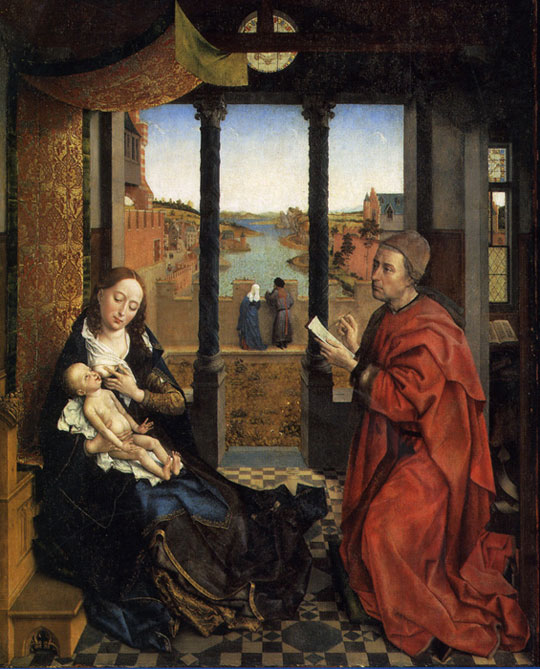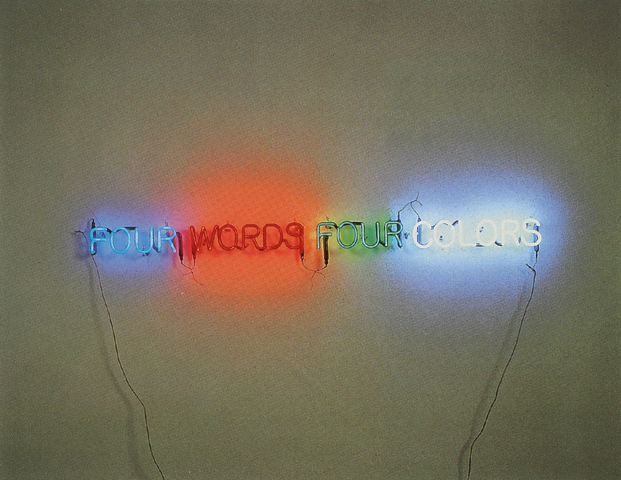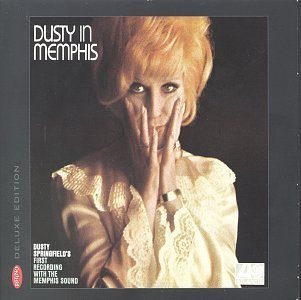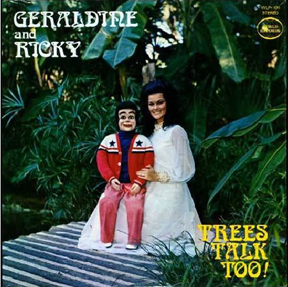We're studying semiotics this week in school. I modified a bit of an assignment for the blog. It's not scintillating, but I gotta post something cause I'm afraid L.M. will abandon me for my bloggy slackerness!

Rogier van der Weyden, St. Luke Drawing the Virgin, c. 1435-40. Image from SUNY- Oneonta

Joseph Kosuth, One and Three Chairs, 1965. Wood folding chair, mounted photograph of a chair, and photographic enlargement of a dictionary definition of “chair.” Image from philosophie-spiritualite.com
Joseph Kosuth’s “One and Three Chairs” reads like a text book illustration for semiotic theory. Here the sign of the chair is presented in three forms, a photograph of a chair, a chair, and a dictionary definition of a chair. Each instance of ‘chair’ functions very differently, yet all three are presented under a third, unifying category — that of art. It is as if the kind of self-reflexive step taken by artists such as Rogier Van der Weyden in his portrayal of St. Luke drawing the Virgin was here presented bare — divested of context and content so that the cognitive act of reference is itself the object of the work.
By choosing a referent as neutral as a chair, Kosuth draws attention to the codes of meaning rather than the content. In a contemporary context, the piece reads as illustrative, dry and didactic. But in the early days of conceptual art, there was an exhilaration to the notion that art ideas were not on reliant physical form. Releasing the idea from the object meant, at that time, emancipation from the market, from aura, from the gallery, from authorship, from genius and a whole host of artworld hierarchies. History has shown that conceptual art was ultimately as susceptible to commodification as other forms, but it did open the door for a slew of modes of meaning.
|
mantegno(?)'s history of reading has a wonderful chapter on the implications of western holy women reading, esp the two marys and anne.
what do you think of kosuth's most recent work, how do you think it relates to the infamous chair peice?
It's been a while since artists' statements have mentioned semiotics. Lets bring it back!
I love semiotics. Anthony, would love to get into your question, but I cannot do it now - gotta run to class and then read about Adorno and Lacan and Benjamin and more. would love to hear what you think though.
Chairs are totally not neutral. Have you read the part in Huxley's 'The Doors of Perception' where he looks at a chair while he's on hallucinogens? Trippy, tricky stuff.
"Chairs are totally not neutral."
Agreed!
Who could forget Chairy and the Dog Chair on Peewee's Playhouse? Or the rocking chair "for those who want to rock" on Friendly Giant?
you guys are right about chairs.
i think its interesting, wrt Kosuth that he went from a well digested peice of narrative construction to large chunks of unprocessed derrida, it seems to be a metaphor for the slide of conceptual art since the 70s
"unprocessed Derrida", uh, is that like cheese?
Yes. Large chunks of it.
It's now my new favourite expression.
http://images.artnet.com/artwork_images%5C140199%5C158959.jpg
A Propos (Reflecteur de Reflecteur), 2004, 86 quotes on Etched Glass lit by white neon.
this was the example i was thinking of--that each quote you pay by the word is an example of the logophillic hamfistedness that seems to have overwhelmed his historically proven good sense
sidenote:
(i am never sure if people are making fun of me ;)
For the record Anthony, I am always making fun of you unless I happen to be making fun of Sally.
"logophillic hamfistedness" ... the three chairs is hamfisted too. But it was timely. I don't know Kosuth's current work, but that image you linked to looks like spectacle (Tron-ish) to me.
You're right on most counts, Sally, interesting how sometimes something timely has a best before date stamped on it.
being ham-fisted is not always a bad thing.
i think that teh chair and the dictionary peices are tight essays on one kind of meaning--i dont think that they are hamfisted at all. elegance is refusal, right--a refusal to do anything over what is requried by the initial concept (thats the great thing about a lot of those early conceptual artsits, have the idea, do the minimum it takes to express that idea, get out of there)
there is no idea in the giant neon peice, no thinking, its overwhelming visual spectacle as a way of distracting from the lack of analysis.
early kosuth would have its roots in pop art. smart pop art with attractive formal appeal. despite his denouncement of formalism, the pieces all have "eye candy" quality.

Joseph Kosuth, Four Words Four Colors, 1965 (from here).
As usual, your description and argument is eloquent Anthony, but I hate Kosuth’s “One and Three Chairs” more than ever as time goes on.
Hey Sally,
What did you mean when you said, " By choosing a referent as neutral as a chair, Kosuth draws attention to the codes of meaning rather than the content."?
Hey Anthony,
What did you mean when you said, "this was the example i was thinking of--that each quote you pay by the word is an example of the logophillic hamfistedness that seems to have overwhelmed his historically proven good sense"?
wordlovin' clumsiness over historically proven good sense of what?
Design mostly. What he is saying in the giant neon peice of doom is "words have meaning, explicit meaning, how do i make this connection as explicit as humanly possible, i have already done the signified/signifier thing at least twice, and now i am in the history books--i know i'll pretend I'm a writer and get paid by the word. Who's a genius now, and ill make it big, huge and white neon, everyone loves white neon..."
"The meaning is the use", Wittgenstein
I just meant that the chair is not the point. The fact that 'chair' has many iterations is the point. If he'd picked a cute fluffy doggy instead, or a speculum, he would've had a harder time laying bare the code, or drawing our attention strictly to the proliferation of iterations (I'm trying not to say "signs").
HaHa! That's funny.
In each case though, he could have presented the same formula, ie. actual cute fluffy dog, photograph of self same animal and finally textual definition etc...how do "iterations" (a decidedly speech related term) differ from variations of visual representation?
well, for one thing, they're not all visual. some iterations, for instance, are representations in our mind! That's the main one...the big ticket iteration.
lorna should do a kosuth rip off w. bat boy
She should.
But what about the "iterations" on Kosuth's wall?
the wall? we're interested in the wall now? hah. that's so postmodern.
A Kosuth rip-off would require a relationship of academic rigour between me and my dog, which is impossible since he left an accident the size of a cow pie on the broadloom in my basement this morning.
(I probably shouldn't of yelled FUCK OFF at him when he was harassing me at 8 am. while I was trying to sleep)
Sally - No, not the wall, the iterations. Are they not an arrangement on a wall?
Sorry. just teasing. not sure what more you're looking for, J. What are you thinking?
You had said some iterations are not visual but representations in our minds.


Yeah.
Actually, you had said, in our mind.
Neutral, no… not to nag I only cite since some may be in grad school; probably Kosuth chose chair as it is Plato’s example in explaining the idea of Forms ((form of Ideas?) but you could ask mb)… or maybe it’s more up bill’s furniture design alley.
yay, historical context! Thanks Alex!
kosuth chose a chair because it was something that he had in the studio that day.
apparently so did plato.
History for Kids! Plato! Chair! Cave! Shadows!
|
We're studying semiotics this week in school. I modified a bit of an assignment for the blog. It's not scintillating, but I gotta post something cause I'm afraid L.M. will abandon me for my bloggy slackerness!
Rogier van der Weyden, St. Luke Drawing the Virgin, c. 1435-40. Image from SUNY- Oneonta
Joseph Kosuth, One and Three Chairs, 1965. Wood folding chair, mounted photograph of a chair, and photographic enlargement of a dictionary definition of “chair.” Image from philosophie-spiritualite.com
Joseph Kosuth’s “One and Three Chairs” reads like a text book illustration for semiotic theory. Here the sign of the chair is presented in three forms, a photograph of a chair, a chair, and a dictionary definition of a chair. Each instance of ‘chair’ functions very differently, yet all three are presented under a third, unifying category — that of art. It is as if the kind of self-reflexive step taken by artists such as Rogier Van der Weyden in his portrayal of St. Luke drawing the Virgin was here presented bare — divested of context and content so that the cognitive act of reference is itself the object of the work.
By choosing a referent as neutral as a chair, Kosuth draws attention to the codes of meaning rather than the content. In a contemporary context, the piece reads as illustrative, dry and didactic. But in the early days of conceptual art, there was an exhilaration to the notion that art ideas were not on reliant physical form. Releasing the idea from the object meant, at that time, emancipation from the market, from aura, from the gallery, from authorship, from genius and a whole host of artworld hierarchies. History has shown that conceptual art was ultimately as susceptible to commodification as other forms, but it did open the door for a slew of modes of meaning.
- sally mckay 10-12-2007 6:11 pm
mantegno(?)'s history of reading has a wonderful chapter on the implications of western holy women reading, esp the two marys and anne.
what do you think of kosuth's most recent work, how do you think it relates to the infamous chair peice?
- anthony (guest) 10-12-2007 6:42 pm
It's been a while since artists' statements have mentioned semiotics. Lets bring it back!
- L.M. 10-12-2007 6:43 pm
I love semiotics. Anthony, would love to get into your question, but I cannot do it now - gotta run to class and then read about Adorno and Lacan and Benjamin and more. would love to hear what you think though.
- sally mckay 10-12-2007 7:49 pm
Chairs are totally not neutral. Have you read the part in Huxley's 'The Doors of Perception' where he looks at a chair while he's on hallucinogens? Trippy, tricky stuff.
- meowpants (guest) 10-12-2007 10:24 pm
"Chairs are totally not neutral."
Agreed!
Who could forget Chairy and the Dog Chair on Peewee's Playhouse? Or the rocking chair "for those who want to rock" on Friendly Giant?
- Rob (guest) 10-12-2007 11:37 pm
you guys are right about chairs.
- sally mckay 10-13-2007 2:39 am
i think its interesting, wrt Kosuth that he went from a well digested peice of narrative construction to large chunks of unprocessed derrida, it seems to be a metaphor for the slide of conceptual art since the 70s
- anthony (guest) 10-13-2007 3:35 am
"unprocessed Derrida", uh, is that like cheese?
- J@simplepposie (guest) 10-15-2007 6:18 am
Yes. Large chunks of it.
It's now my new favourite expression.
- L.M. 10-15-2007 6:34 am
http://images.artnet.com/artwork_images%5C140199%5C158959.jpg
A Propos (Reflecteur de Reflecteur), 2004, 86 quotes on Etched Glass lit by white neon.
this was the example i was thinking of--that each quote you pay by the word is an example of the logophillic hamfistedness that seems to have overwhelmed his historically proven good sense
sidenote:
(i am never sure if people are making fun of me ;)
- anthony easton (guest) 10-15-2007 9:55 pm
For the record Anthony, I am always making fun of you unless I happen to be making fun of Sally.
- L.M. 10-15-2007 11:55 pm
"logophillic hamfistedness" ... the three chairs is hamfisted too. But it was timely. I don't know Kosuth's current work, but that image you linked to looks like spectacle (Tron-ish) to me.
- sally mckay 10-16-2007 3:54 am
You're right on most counts, Sally, interesting how sometimes something timely has a best before date stamped on it.
- L.M. 10-16-2007 4:13 am
being ham-fisted is not always a bad thing.
- sally mckay 10-16-2007 5:05 am
i think that teh chair and the dictionary peices are tight essays on one kind of meaning--i dont think that they are hamfisted at all. elegance is refusal, right--a refusal to do anything over what is requried by the initial concept (thats the great thing about a lot of those early conceptual artsits, have the idea, do the minimum it takes to express that idea, get out of there)
there is no idea in the giant neon peice, no thinking, its overwhelming visual spectacle as a way of distracting from the lack of analysis.
- anthony (guest) 10-16-2007 1:22 pm
early kosuth would have its roots in pop art. smart pop art with attractive formal appeal. despite his denouncement of formalism, the pieces all have "eye candy" quality.
- bill 10-16-2007 4:42 pm
Joseph Kosuth, Four Words Four Colors, 1965 (from here).
- sally mckay 10-16-2007 5:19 pm
As usual, your description and argument is eloquent Anthony, but I hate Kosuth’s “One and Three Chairs” more than ever as time goes on.
- L.M. 10-16-2007 8:07 pm
Hey Sally,
What did you mean when you said, " By choosing a referent as neutral as a chair, Kosuth draws attention to the codes of meaning rather than the content."?
- J@simpleposie (guest) 10-16-2007 8:29 pm
Hey Anthony,
What did you mean when you said, "this was the example i was thinking of--that each quote you pay by the word is an example of the logophillic hamfistedness that seems to have overwhelmed his historically proven good sense"?
wordlovin' clumsiness over historically proven good sense of what?
- J@simpleposie (guest) 10-16-2007 8:34 pm
Design mostly. What he is saying in the giant neon peice of doom is "words have meaning, explicit meaning, how do i make this connection as explicit as humanly possible, i have already done the signified/signifier thing at least twice, and now i am in the history books--i know i'll pretend I'm a writer and get paid by the word. Who's a genius now, and ill make it big, huge and white neon, everyone loves white neon..."
- anthony (guest) 10-16-2007 11:32 pm
"The meaning is the use", Wittgenstein
- J@simpleposie (guest) 10-17-2007 12:11 am
I just meant that the chair is not the point. The fact that 'chair' has many iterations is the point. If he'd picked a cute fluffy doggy instead, or a speculum, he would've had a harder time laying bare the code, or drawing our attention strictly to the proliferation of iterations (I'm trying not to say "signs").
- sally mckay 10-17-2007 12:33 am
HaHa! That's funny.
In each case though, he could have presented the same formula, ie. actual cute fluffy dog, photograph of self same animal and finally textual definition etc...how do "iterations" (a decidedly speech related term) differ from variations of visual representation?
- J@simpleposie (guest) 10-17-2007 2:15 am
well, for one thing, they're not all visual. some iterations, for instance, are representations in our mind! That's the main one...the big ticket iteration.
- sally mckay 10-17-2007 3:01 am
lorna should do a kosuth rip off w. bat boy
- anthony (guest) 10-17-2007 3:43 am
She should.
- J@simpleposie (guest) 10-17-2007 4:18 am
But what about the "iterations" on Kosuth's wall?
- J@simpleposie (guest) 10-17-2007 4:20 am
the wall? we're interested in the wall now? hah. that's so postmodern.
- sally mckay 10-17-2007 4:35 am
A Kosuth rip-off would require a relationship of academic rigour between me and my dog, which is impossible since he left an accident the size of a cow pie on the broadloom in my basement this morning.
(I probably shouldn't of yelled FUCK OFF at him when he was harassing me at 8 am. while I was trying to sleep)
- L.M. 10-17-2007 4:45 am
Sally - No, not the wall, the iterations. Are they not an arrangement on a wall?
- J@simpleposie (guest) 10-17-2007 5:24 am
Sorry. just teasing. not sure what more you're looking for, J. What are you thinking?
- sally mckay 10-17-2007 5:11 pm
You had said some iterations are not visual but representations in our minds.
- J@simpleposie (guest) 10-17-2007 5:25 pm
- bill 10-17-2007 7:53 pm
- L.M. 10-17-2007 8:05 pm
Yeah.
- J@simpleposie (guest) 10-17-2007 8:34 pm
Actually, you had said, in our mind.
- J@simpleposie (guest) 10-18-2007 12:45 am
Neutral, no… not to nag I only cite since some may be in grad school; probably Kosuth chose chair as it is Plato’s example in explaining the idea of Forms ((form of Ideas?) but you could ask mb)… or maybe it’s more up bill’s furniture design alley.
- alex 10-19-2007 2:40 am
yay, historical context! Thanks Alex!
- sally mckay 10-19-2007 2:50 am
kosuth chose a chair because it was something that he had in the studio that day.
- anthony (guest) 10-20-2007 1:58 pm
apparently so did plato.
- bill 10-20-2007 4:01 pm
History for Kids! Plato! Chair! Cave! Shadows!
- L.M. 10-20-2007 4:29 pm